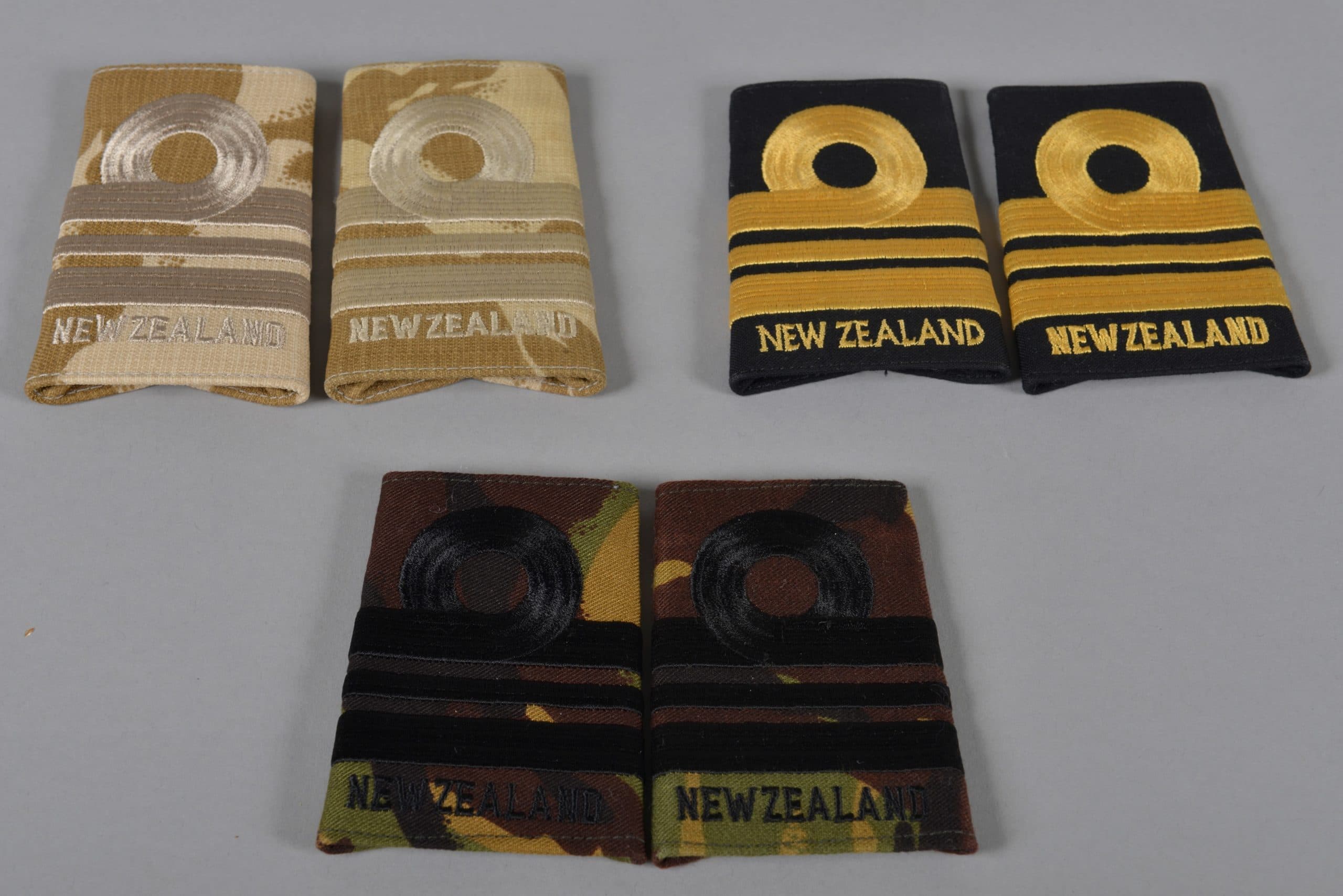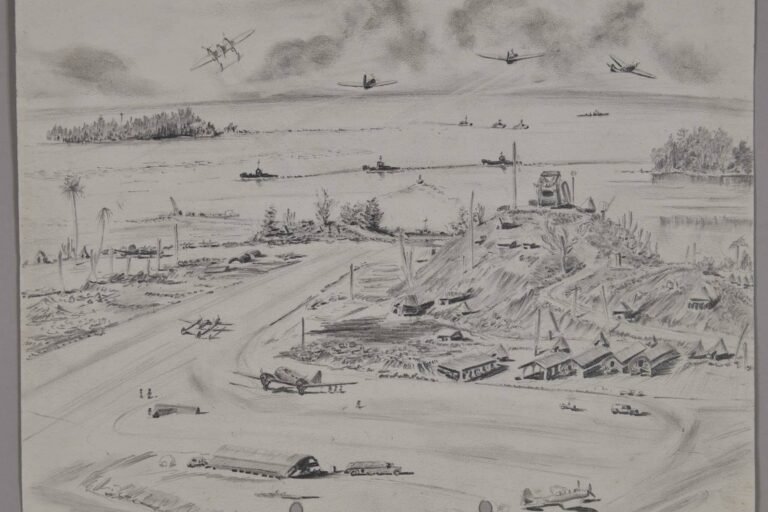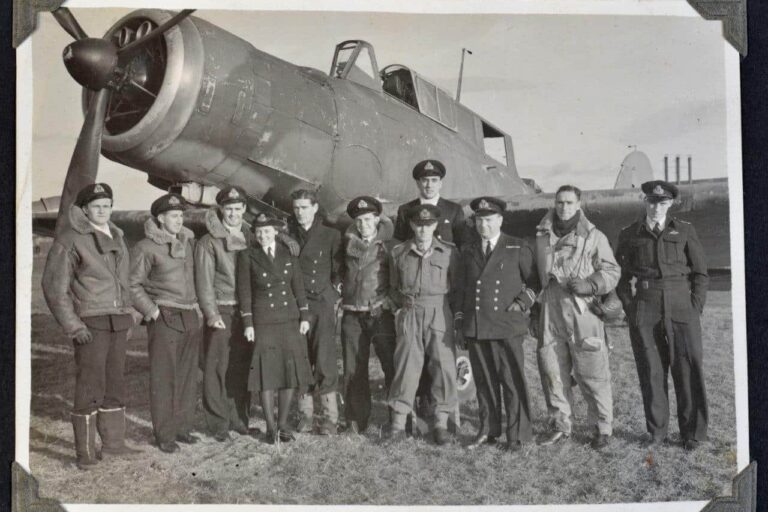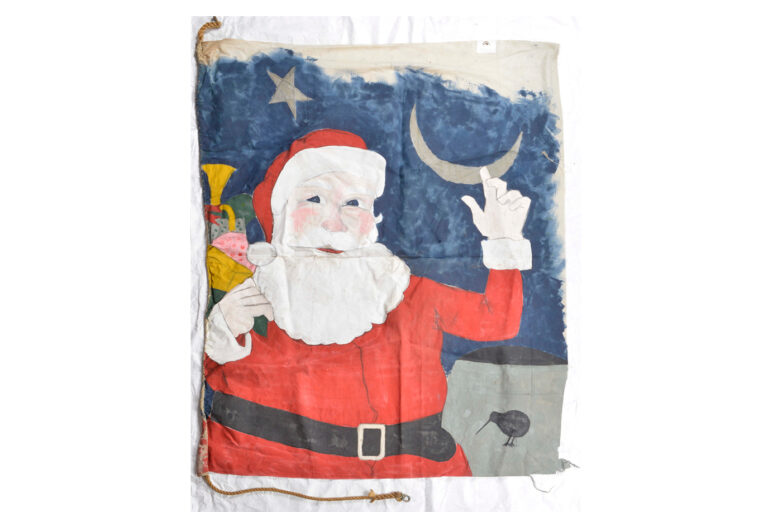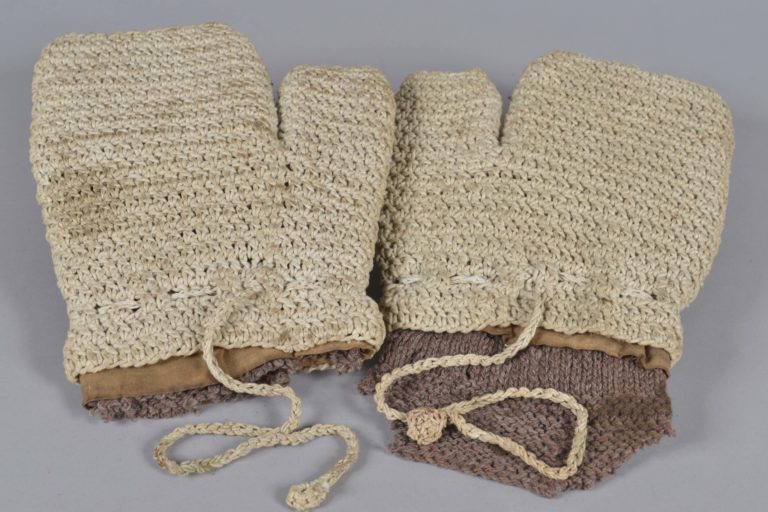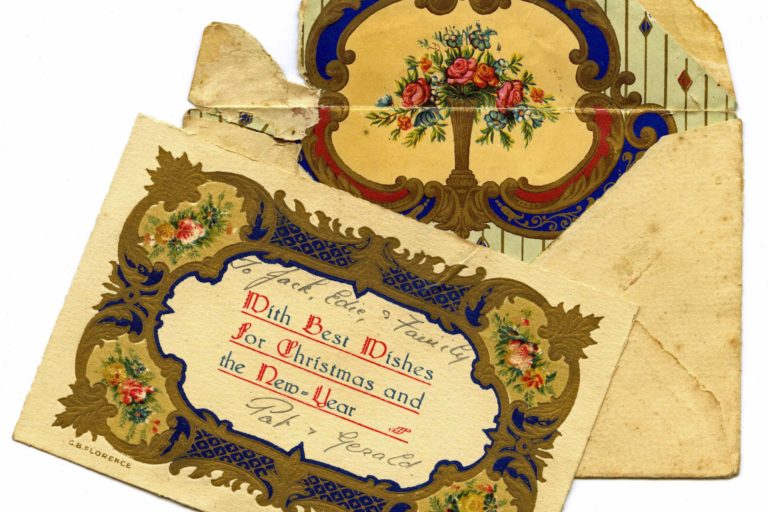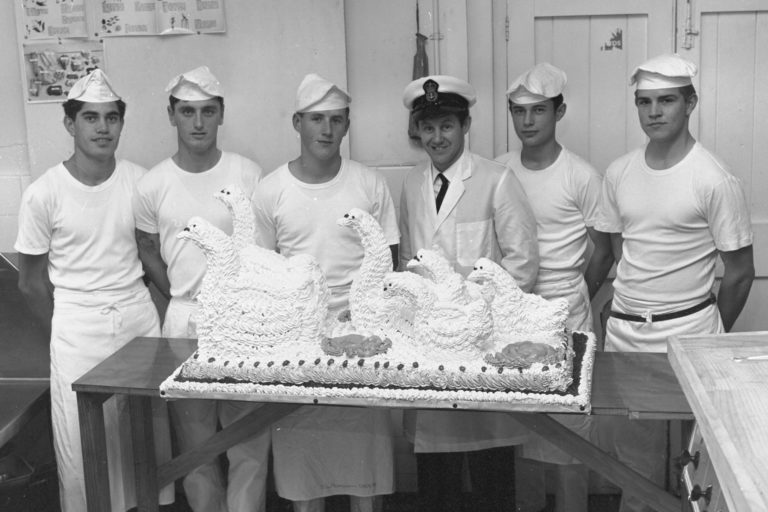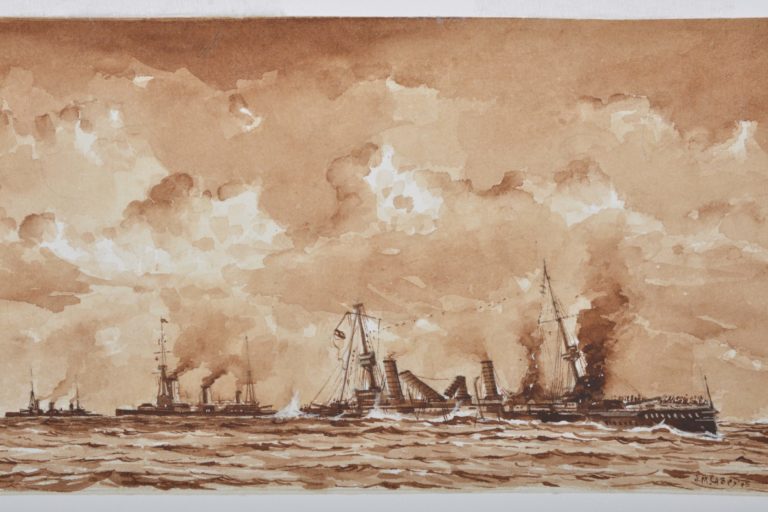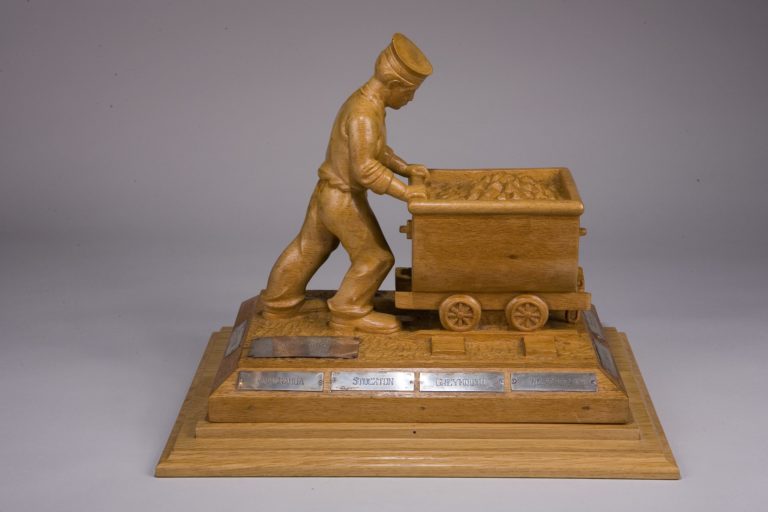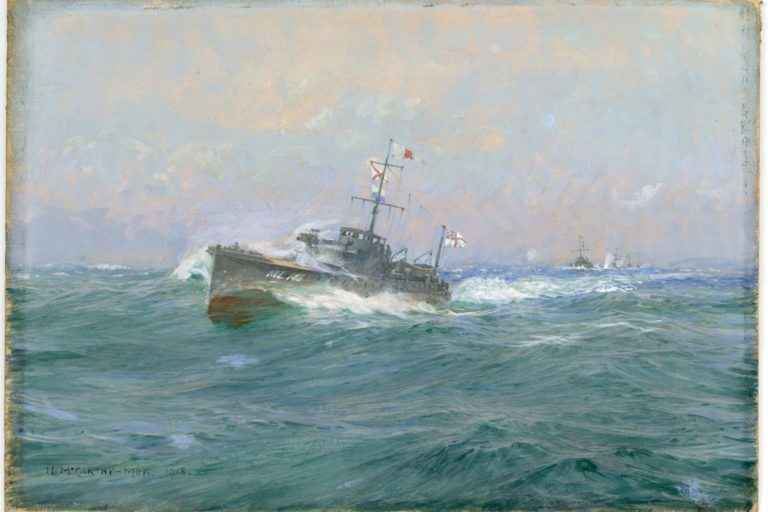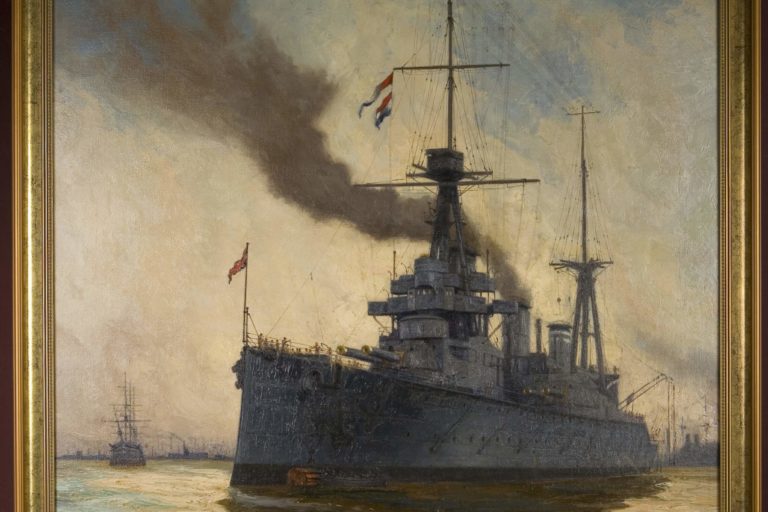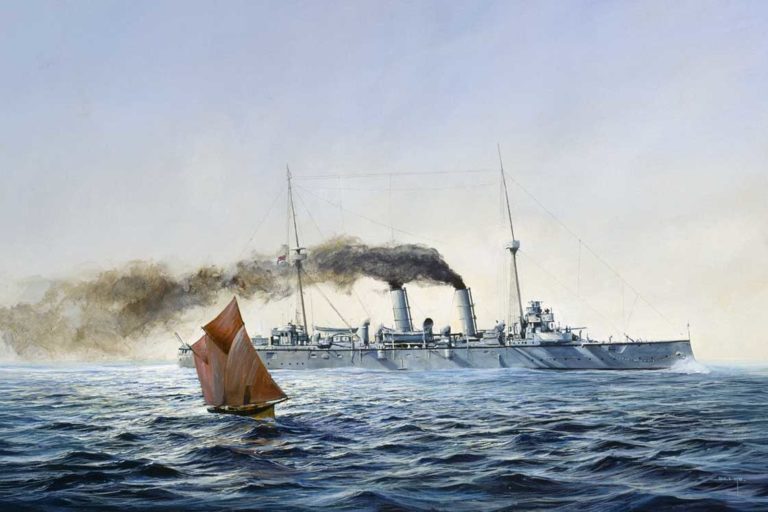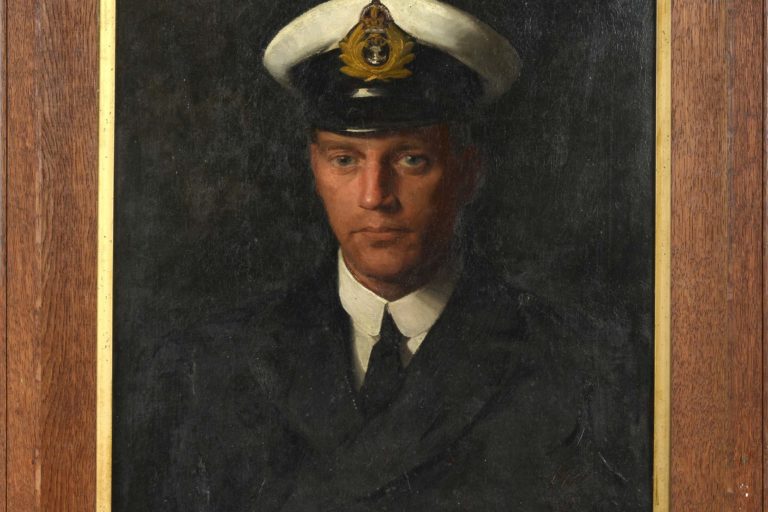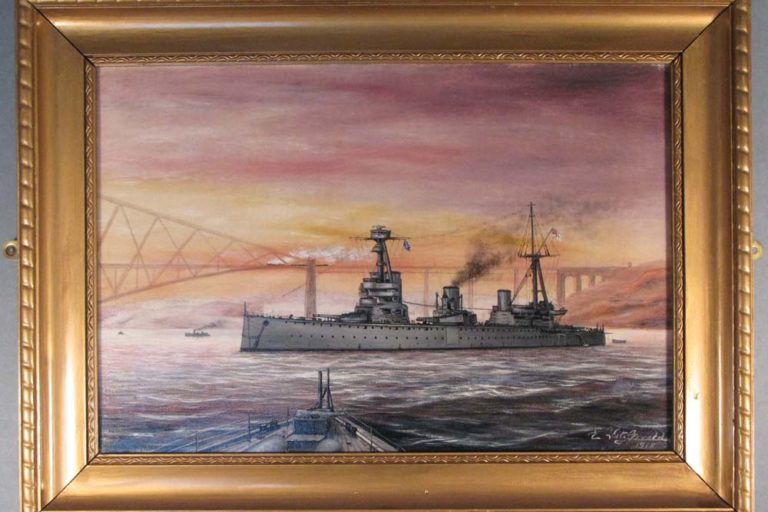Background
The history of ranks and rates within the Navy is tied to development of language and naval custom. As you will see, these titles have their origins in languages other than English but over time became Anglicised, and then entered into common usage within the Royal Navy and those navies that followed the senior service’s tradition and customs. It is important here to note that officers in the navy have ranks and those below officer rank have a rating. The colloquial terms used are stripee (referring to the good conduct stripes worn on the sleeve) for ratings and ringers for officers. As a further distinction, ratings display their specialist trade on the right arm and their rate on the left. There were are then are still two ways to reach officer rank; either work you way through the ratings and obtain a commission or be commissioned directly as an officer.
Admiral
This rank title has it origins in the Arabic amir-al-bahr translated as “Admiral of the Seas”. This rank first appeared in England in 1297 when Edward I named William de Leyburn as ‘Admiral of the Sea of the King of England’. The first royal commission as Admiral to a naval officer was granted in 1303. By 1344 it was only used as a rank at sea for a captain in charge of a fleet or fleets.[1] The rank of Vice-Admiral evolved from that of Lieutenant-Admiral, that being an officer who acted as secretary to the Admiral and lapsed in 1876 but was revived in 1901 by King Edward VII and is now the most senior rank within the Navy. The rank of Rear-Admiral is the rank subordinate to Vice-Admiral.[2] The rank of Rear Admiral is denoted by a broad gold band and one stripe, and two stars on the shoulder board. A Vice-Admiral has a broad gold band and two stripes, and three stars on the shoulder board and the rank of Admiral has a broad gold band and three stripes and four stars on the shoulder board.
Commodore
The word ‘Commodore’ is of French origin and came into use by the English in the 17th century around the time of the Dutch Wars of 1652.[3] It would appear that William III introduced the rank into the Royal Navy from the Dutch Navy. Other uses of the title are a senior captain of a fleet of merchant ships, a captain of pilots, and President of a yacht club. Officers are shown in the rank of Commodore in the navy list of 1795 but not officially until 1806.[4] By the mid 19th century the rank was non-substantive although associated with certain shore posts and as a courtesy title for the senior officer of a group of three or more ships.
In its modern form there were, until the 1980s two classes of Commodore, first and second, both of which were non-substantive. Commodores First Class wore the uniform of a Rear Admiral and was entitled to fly a broad pendent which was white with a red St. George’s Cross. Commodores Second Class denoted their rank with the broad strip in use today and their broad pendant was distinguished from that of the Commodore First Class by the addition of a red ball in the upper left canton. The Royal Navy in the 1980s introduced the substantive rank of Commodore, although it was understood that not officers will be promoted through the rank, i.e. Captains may still be promoted direct to Rear Admiral.[5] Currently, the Deputy Chief of the Royal New Zealand Navy is a Commodore. The rank of Commodore is denoted by a broad gold band
Captain
The origins of the word are from the Saxon word for chief caput. Prior to the 14th century the commander of a ship was known as a Batsuen (Boatswain) or another higher rank which was known as a Reçtor. In about 1380 the rank of Captain was established and entered use which was a higher rank that Master who was in charge of sailing the ship. By the seventeenth century there were two types of Captain Rank; those who had advanced from junior ranks and those who were promoted directly to the rank. By 1748 it was deemed that any officer in command of the ship was entitled to the rank of captain while in command of the ship.[6] The rank of Captain is denoted by four gold stripes.
Commander
Prior to 1794 this rank was known as Master and Commander and was only for those commanding officers of warship with less than 24 guns, a sloop, or bomb vessels. It was simplified in 1794 to Commander. In 1827, the Royal Navy determined Commander as a rank for those who were in second-in-command of the largest warships in the Navy, a move that took some time to be popular.[7] The rank of Lieutenant-Commander did not come into use until 1914 when the Royal Navy converted the rank of Senior Lieutenant. The rank of Lieutenant Commander is denoted by three gold stripes, with the middle stripe half as thick while the rank of Commander is denoted by three gold stripes.
Lieutenant
The word comes from the French word which translates as ‘one who replaces’. This rank was introduced in 1850 to provide the commanding officer of a ship with an executive assistance suitably qualified to command the vessel in his absence or if he was disabled.[8] The rank of Lieutenant is denoted by two gold stripes.
Sub-lieutenant
This was introduced into the Royal Navy in c1811but was not adopted. It was not until 1861 that it was reintroduced in lieu of the previous rank of Mate.[9] The rank of Sub Lieutenant is denoted by a single gold stripe.
Ensign
The RNZN introduced the rank of Ensign in 1968 as a result of changes to training policy and procedures. The rank of Naval Cadet had been abolished in the 1950s. Unlike the United States Navy which replaced the rank of midshipman with Ensign in 1862, from 1968 the RNZN has kept both ranks as part of the naval command structure. The rank insignia is a half ring as the Sub-Lieutenants were given a single full ring which meant the ranks above advanced one ring or half a ring the in the case of Lt-CDRs. This rank is used in the RNZN to donate a Midshipman of two years standing.
Midshipman
The term originally denoted men stationed amidships and was first mentioned in the seventeenth century. Until it was formalised in 1815 as a rank it was purely a ship’s rating. Up until that time midshipmen were “young gentlemen, not under the age of eleven years who were intended for the sea service…”[11] In order to advance to the rank of Lieutenant, the young gentleman had to spend six years at sea, including two years as a midshipman or mate.[12] In 1837, with the creation of HMS Illustrious as a cadet training ship at Portsmouth, it appears that the rank of midshipman was transferred to officer cadets undergoing training.[13] Since then that term has applied to all officer cadets in navies that have followed the Royal Navy tradition including the RNZN. This is the most junior commissioned rank in the RNZN identified by a white tab on the collar with a button in the centre.
Warrant Officer
In the 11th century warships needed men who were skilled in seamanship to take the ships to sea with their complement of soldiers.[14] The officers that led the soldiers were commissioned by the King while the seamen were given the equivalent of a commission – known as a Warrant. These would be issued from whoever the naval authorities of the day were. This process continued down through time as the Royal Navy developed. For example, by the 16th Century, Warrants were issued to a ship’s master, purser, gunner, boatswain, carpenter etc.[15] By the 17th century ship’s masters were very well paid when compared to other warrant officers.[16] When a set of regulations were issued in 1806 there were three classes of WO in the Royal Navy of fourteen ranks First Class Masters, Second Masters, Surgeon, and Chaplain, Second Class Gunner, Boatswain, Carpenter, Purser, and School-Master and Third Master-at-Arms, Cook, Sail-maker, Rope-maker, and Caulker. In 1859, the Royal Commission into Manning of the Navy took evidence on the poor status of WO in the RN and made several recommendations about pay and conditions. Immediately WO were restored in rank after Second Masters and the RN would consider promotion to commissioned rank from WO.[17] In 1872 WO’s names were first published in the Navy List. This was followed by abolishing of different classes of WO. Interestingly, Army WO were considered to be beneath in rank to Naval WO.[18]
As with officers, it seems the period 1860-1925 was one of continual change for the Warrant Officers of the Royal Navy. They were also very politically active, always lobbying senior commanders and MPs for improvements to their conditions of service. As a body, WO in this period felt overlooked and underappreciated. In smaller warships, they were still keeping the watch, acting as gunners and boatswains, tasks aboard ship that were beneath their skill level. One of the WO ‘friends’ was a Commander John Fisher who made a great impression on WO under his command aboard HMS Ocean in the 1880s. It would be as Admiral Fisher, Second Sea Lord in 1902 and responsible for personnel that he would make further changes and improve the lot of all ratings and officers. He clearly understood that it was the human element that won battles, not the ships themselves.[19] He was to write that ‘the lower deck richly deserves all we [the Admiralty] can do…our warrant and petty officers are competent for higher positions… and for the good of the Service their status must be raised.”[20] It had been the practice to promote WO with long service to Lieutenant as they came to end of their career. This was more a courtesy than good practice and again showed the ambivalence that the RN showed the position of WO in the fleet.
In 1910, Writers, Stewards, MAA, and Cooks were allowed to become WO.[21] Schemes to let PO to be promoted acting WO then undertake the courses as Sub-Lieutenants and get a commission as a Sub-Lieutenant. By the outbreak of the First World War, selected WO and PO went through as course of training then were given the position of Mate before being commissioned as a Sub-Lieutenant. 44 men were in this scheme as former PO and 200 WO were given the promotion to Chief Warrant Officer after fifteen years service.[22] During the war many WO gained a commission and mainly served in small craft. Those with Warrants struggled in the interwar period. In the Second World War, most WO were given temporary wartime commissions. Post war the situation changed again. Warrants were given to senior ratings as a promotion and were treated as a key part of the command structure. In the NZDF WO exist in all three branches and are equal in their authority.
Chief Petty Officer
The rank of Chief Petty Officer (CPO) was instituted in 1853 by an Admiralty Committee report on manning. No arm badges were required to be worn but rather attached to the collar with some exceptions for artificer CPOs.[23] This order in council was in part to address the manning crisis that the Royal Navy had to endure with the end of the press-gang system. The rate of CPO was introduced to replace the following ranks:
- chief boatswain’s mate
- chief captain of the forecastle
- admiral’s coxswain
- chief quartermaster
- chief carpenter’s mate
- seamen’s schoolmaster
- ship’s steward
- ship’s cook
Pay and conditions were also improved along with this rank. [24]
Petty Officer
The rate Petty Officer can trace the title back to the old French word, petit meaning something small. Over the years, the word also came to mean minor, secondary, and subordinate. In medieval and later England just about every village had several “petite”, “pety” or “petty” officials/officers who were subordinate to such major officials as the Steward of Sheriff. The petty officers were the assistants to the senior officials.
The senior officers of the early British warships, such as the Boatswain, Gunner and Carpenter, also had assistants or “mates.” Since the early seamen knew petty officers in their home villages they used the term to describe the minor officials aboard their ships. A ship’s Captain or Master chose his own Petty Officers who served at his pleasure. At the end of a voyage or whenever the ship’s crew was paid off and released, the Petty Officers lost their positions and titles. There were Petty Officers in the British navy in the Seventeenth Century and perhaps earlier but the rank did not become official until 1808.
Petty Officers were important members of the ship’s companies and were also appointed by their ship’s Captain. They did not have uniforms or rank insignia, and they usually held their appointments only while serving on a ship with the Captain had selected them.[25] Until 1853, when Chief Petty Officer and leading rate rating were introduced, Petty Officer was the only rate above Able Rate.[26] Master-at-arms used to have Ship’s Corporals that became known as Regulating Petty Officers from 1913-14 in the Royal Navy.[27] Up until 1913 there were two classes of Petty Officer when the Royal Navy abolished Petty Officer Second Class as a rate.
Boatswain
Pronounced bo’sun, the origin for this name comes from the Saxon for servant swein, thus a boatswain meant a servant of the boat. A boatswain is charged with the responsibility for the anchors, cables, hawsers, rigging and other sea gear.[28] In the RNZN a boatswain is a rating.
Leading Seaman
This rate is for a Able Seaman who has taken courses in his branch trade and is suitable for promotion to a senior rate.
Able Seaman
This rate is given to those sailors who have been in the Navy for at least two years. This is a sailor who had been to sea and knows his way around the ship and is trained in his branch trade.
Ordinary Seaman
The rate was given to those men who joined and had passed through basic training and were being sent to their first sea posting or branch training. It was also given to those Boy Seamen who had reached 18 years and were now undertaking their term of engagement with the Royal Navy
Junior/Boy Seaman
Boys who were aged under 18 were known as Boy Seamen. They usually joined at 13-15 years and were trained and educated. Aboard ship they had an instructor officer. They were also subject to corporal punishment unlike the adult sailors.
[1] Rear-Admiral Gerard Wells, Naval Customs & Traditions, London: Phillip Adam, 1930, pp. 1-2.
[2] Commander A B Campbell, Customs and Traditions of the Royal Navy, Aldershot: Gale & Polden, 1956, p. 139.
[3] Rear-Admiral Gerard Wells, Naval Customs & Traditions, London: Phillip Adam, 1930, p. 41.
[4] ibid.
[5] Peter Dennerly, Naval Museum minute June 1989, Research archive No. 33.
[6] Commander A B Campbell, Customs and Traditions of the Royal Navy, Aldershot: Gale & Polden, 1956, p. 143.
[7] Rear-Admiral Gerard Wells, Naval Customs & Traditions, London: Phillip Adam, 1930, pp. 40-41.
[8] ibid., p. 94. See also Commander A B Campbell, Customs and Traditions of the Royal Navy, Aldershot: Gale & Polden, 1956, p. 151.
[9] ibid., pp. 54, 157.
[10] ibid., p. 54.
[11] ibid., p. 106.
[12] ibid., p. 107.
[13] ibid., p. 108.
[14] Lieutenant G. Gibbs RN, Royal Naval Officers’ Manual 1928, Portsmouth: Naval Warrant Officers’ Journal, 1927, p. 1.
[15] ibid.
[16] Michael Lewis, England’s Sea-Officers: The Story of the Naval Profession 2nd ed., London: George Allen & Unwin, 1948, p. 226.
[17] Lieutenant G. Gibbs RN, Royal Naval Officers’ Manual 1928, Portsmouth: Naval Warrant Officers’ Journal, 1927, pp. 16-17.
[18] ibid., p. 19.
[19] Captain John Wells, The Royal Navy: A Illustrated Social History 1870-1982, Phoenix Mill: Allan Sutton Publishing, 1994, p. 58.
[20] ibid., p. 87.
[21] Lieutenant G. Gibbs RN, Royal Naval Officers’ Manual 1928, Portsmouth: Naval Warrant Officers’ Journal, 1927, pp. 24-25.
[22] Captain John Wells, The Royal Navy: A Illustrated Social History 1870-1982, Phoenix Mill: Allan Sutton Publishing, 1994, p. 87.
[23] Capt. W.N.T. Beckett, A Few Naval Customs, Expressions, Traditions, and Superstitions, Portsmouth: Gieves Ltd., n.d., p. 70.
[24] A. Cecil Hampshire, Just an Old Navy Custom, London: William Kimber, 1979, pp. 19-21.
[25] https://wrc.navair-rdte.navy.mil/warfighter_enc/history/rankrate/pettyoff.htm Accessed November 2007
[26] John Hard, Royal Navy Language, Lewes: The Book Guild, 1991, p. 85.
[27] Capt. W.N.T. Beckett, A Few Naval Customs, Expressions, Traditions, and Superstitions, Portsmouth: Gieves Ltd., n.d., p. 51.
[28] Rear-Admiral Gerard Wells, Naval Customs & Traditions, London: Phillip Adam, 1930, p. 24. See also Joseph Palmer, Jane’s Dictionary of Naval Terms, London: 1975, p. 23 and Commander A B Campbell, Customs and Traditions of the Royal Navy, Aldershot: Gale & Polden, 1956, p. 141.


